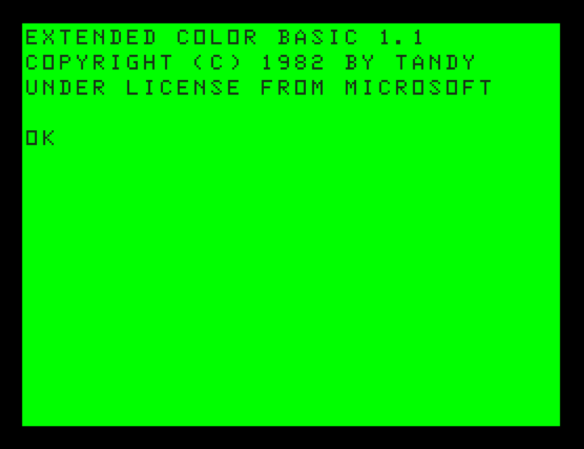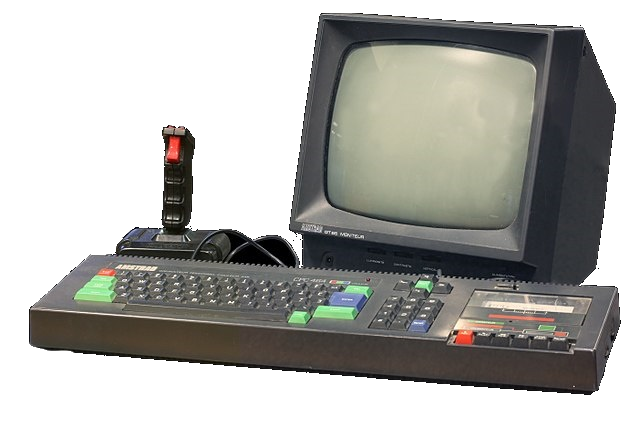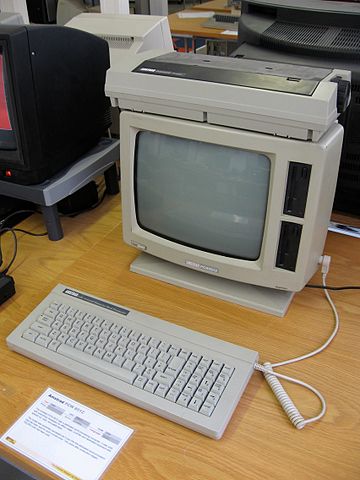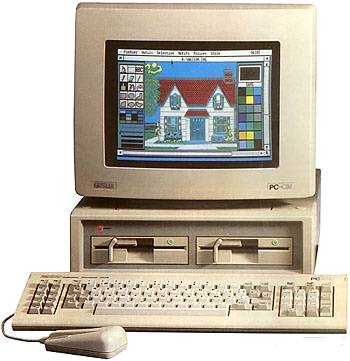

Over the years I have attempted to write software in a variety of Languages. If we take a short trip down memory lane, back thru the mists of time to when dinosaurs still roamed the earth, (and I was 'quite' young), we arrive at that point in 1982 when I passed the local 'Tandy' store in York,(now long since closed), and spotted a weird looking gizmo in the window.

It was hooked up to a portable TV and the screen looked exactly like this ...
An online emulator for the Tandy CoCo (Color Computer) can be found > Here < and a Wikipedia Article about the machine can be found > Here <
Now, I had never really seen a computer up close before and was a little fascinated by this machine ... I really should have kept walking, it would have saved me thousands of £££ and hour after hour of (what felt like) the fruitless pursuit of programming perfection.
But, truthfully, once exposed to the joys of a BASIC program that actually worked ... well I was hooked, and spent well over a year beavering away in the spare room on my 'Computer', whilst marvelling at the screen of 16 Lines X 32 characters of uppercase only Text and (what the salesman had described as) a massive 16k of RAM /sarcasm/.
After 18 months or so 'Learning' on the CoCo, Alan Sugar (now Lord Sugar) found his MoJo and released the first in a long line of AMSTRAD Personal Computers... My Hobby was about to get 'Very' expensive

The >AMSTRAD 464 Green Screen< retailed at an eminently reasonable price of £199. The games and tools however ... not so much
But, needs must, so a machine language compiler was purchased from (I think) 'HiSoft' and since the 464 used a Zilog Z80 chip (The CoCo used a Motorola 6809E) a whole new learning process began. Aided in no small part by a purchase of 'Programming the Z80' by Rodney Zaks ... Brilliant book that included every Z80 op-code and facilitated some serious learning ...
What Fun! Yes, I know, I must be a very sad person to get so much enjoyment from a 'Machine' ... but I plead guilty as charged ... and what fun I had.
Course such unrestrained pleasures couldn't possibly be allowed to last ...
Alan Sugar again ...

Having released 2 more models in the CPC range (the 664 - essentially a 464 + a disk drive and later a 6128 - which was a 664 + an extra 64k of RAM)
Mr Sugar then pulled a rabbit from his hat.
Called the >PCW 8256< , and shipped with both a Printer and Locoscript Word Processing Software, this was a machine for Home use AND the Office.
The CPC series of computers sold around 3,000,000 units in total (which was really rather respectable for the 1980's) BUT the PCW range eclipsed that result by selling 8,000,000 units (Eight Million units in a new market ... I may be severely unimpressed by Mr Sugar and his politics, but I remain very impressed by Mr Sugar and his computers).
This new machine retailed at £399+VAT which was astounding value for a full fledged Word Processor ... But wait, the PCW also shipped with CP/M Plus, making available a wide range of other software and through the use of compilers enabled users to write their own.
Couldn't possibly last could it? ... but so many different and useful ways of using a PCW, 'Fun' doesn't even come close to it ... People wrote books on this machine, Others used it to write clever software, whilst some just fired up the PCW and played simple games,(and I seem to remember a version of 'The Game of Life' being hidden within the Locoscript software)
I 'really' loved using and owning this machine and had an absolute ball writing Machine Code Bits'N'Pieces for it ... but times passes ... so
Back to Mr Sugar and his magical hat.

The AMSTRAD PC1512 was launched in 1986 and proved to be ... amazing. An IBM Compatible machine, that ran (and was supplied with) MS-DOS3.2, DR-Dos, GEM (A Graphical Desktop Manager), had 2 5¼ inch Disk Drives, built-in graphics adapter, built in parallel printer port, 3 free expansion slots (which was a big deal since if you bought IBM equipment slots were taken up with video cards, serial ports, printer ports etc)
This machine quickly gained an astonishing 25% of the European market. Running everything that an IBM could run ... Lotus 123, dBase II/III, Wordstar etc, but it was the release of software such as Borlands Turbo Pascal & Turbo C that supercharged the use and value of a 1512. Anything written on the AMSTRAD machine would run on any IBM Machine and all the other IBM 'Copies'.
Sadly for Alan Sugar, this (along with the AMSTRAD 1640) was the last of the 'Supremely Successful' computers that he built, (oh he built others, but there was more competitors now, all doing what AMSTRAD had ... Build it well, but build it cheap). But, no matter, the technology was moving on at warp speed, with the release of the Intel 80186/80286/80386 chips ... and IBM's adoption of Micro Channel Architecture (MCA) and release of PS/2 & OS/2.
It was also the last machine I ever bought as a pre-built ready to use computer. I graduated to building my own machines using parts available on the open market.
Well, that (shortish!) trip down memory lane is 5 minutes of your life that you wont ever get back ... So ... moving on
My first serious 'Programming Language' of choice was Borlands Turbo Pascal. Written by Anders Hejlsberg (who went on to author - with others - the Microsoft language C#) TP proved to be something of a game changer, added to MS-Dos and running on IBM clones it enabled 'Anyone' to design and write software for the open market.
Over time, Microsoft moved to the Windows Environment and companies like Borland sought to stay relevant by updating Turbo Pascal, first to be Borlands Object Pascal and then to Borlands 'Delphi'. This product is still around (now marketed by Embarcadero) and being used for professional development today, a Community version (10.4 last time I looked) can be downloaded and used for free from> HERE <